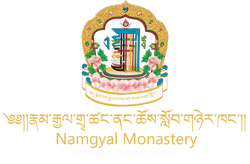
Namgyal Monastery
Tibet and India
History of Namgyal Monastery
Namgyal Monastery was founded in 16th-century Tibet by the second Dalai Lama, Gendun Gyatso. Since its founding, the Namgyal monks have assisted the Dalai Lamas in public religious affairs and have performed ritual prayer ceremonies for the welfare of Tibet. The monastery was also established as an esteemed center of learning, contemplation, and meditation on the vast and profound Buddhist treatises.
Situated in Lhasa next to the Potala Palace, the private residence of the Dalai Lamas, Namgyal Monastery has played an integral role in the Tibetan religious establishment over the centuries. Learn More
Namgyal Monastery in Exile: Dharamsala, India

As a result of the Chinese invasion of Tibet in 1959, His Holiness the 14th Dalai Lama and one hundred thousand Tibetans fled to India and Nepal. Among the original refugees were 55 monks from Namgyal Monastery. After His Holiness the Dalai Lama was granted asylum in the Northern Indian town of Dharamsala, Namgyal Monastery was re-established very nearby the new residence of His Holiness.
To this day, nearly fifty years later, the Tibetan religious, artistic and intellectual traditions are being preserved and maintained through the cooperative effort of the Dalai Lama and the Namgyal monks.
The curriculum and the rigors of monastic life have been meticulously maintained throughout the journey from Tibet into exile. The novice monks of today must first pass a series of challenging entrance examinations and, if accepted, undertake the traditional years of philosophical study.
Since the Namgyal monks assist His Holiness the Dalai Lama and are frequently traveling with him, they require a more streamlined course of study focusing on the essentials of sutra and tantra. His Holiness the 14th Dalai Lama has innovatively addressed and modified the traditional curriculum, including a new syllabus and program of study, which is becoming a model for other Tibetan monasteries.
A Namgyal monk’s average day consists of two hours of ritual, two hours of sacred arts, three hours of philosophy classes, two and a half hours of debate, and several hours of meditation and personal study. Students who successfully complete the thirteen-year program receive the degree of Master of Sutra and Tantra from Namgyal Monastery.
Each monk is also required to complete meditation retreats for each of the principal deities and protectors, as well as receive training in ritual activities. Some of these activities include the making of ritual cakes, the construction of mandalas, the performance of sacred music and dance, and other traditional Tibetan Buddhist rituals.

These traditions are imparted both orally and according to texts. The cycle of retreats required for the study and practice of rituals performed by the monastery might take five or six years to complete, after which, a monk is free to pursue whatever personal retreat practice he chooses.
Cultural Ambassadors to the West

The opportunity to accompany the Dalai Lama on his visits abroad has enabled the Namgyal monks to participate in numerous presentations of Tibetan sacred art and dance throughout much of the world.
In the summer of 1988, monks from Namgyal Monastery created a sand mandala at the American Museum of Natural History in New York. Over 50,000 people came to watch this process during the six week demonstration. Historically, the creation of sacred sand mandalas was always carried out in secret, but the Dalai Lama has now given permission for the public to witness these sacred arts.
In the summer of 1989, Namgyal monks assisted His Holiness with a Kalachakra initiation in Los Angeles. While one group of monks performed the preliminary rituals, including the creation of a sand mandala and the performance of two ritual dances, another group of four monks created a duplicate mandala at the Los Angeles Museum of Natural History.
Since then, Namgyal monks have created sand mandalas at numerous museums and galleries, including the San Francisco Asian Art Museum, the Herbert F. Johnson Museum of Art at Cornell University, and the IBM Gallery in New York City, setting records for attendance at many locations. Through their cultural and spiritual teachings, the Namgyal monks have brought the awareness of the culture and religion of Tibet to the world.





